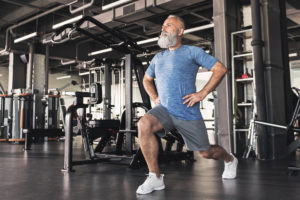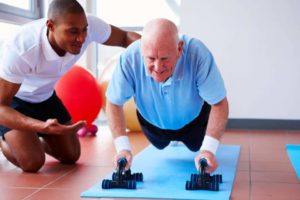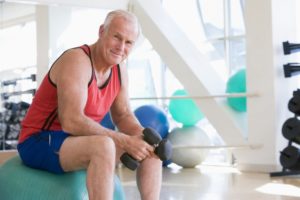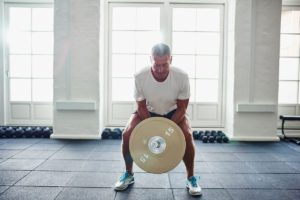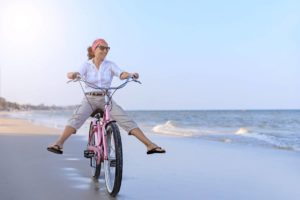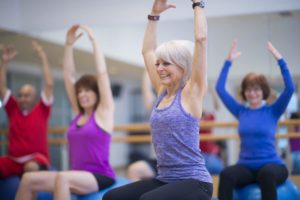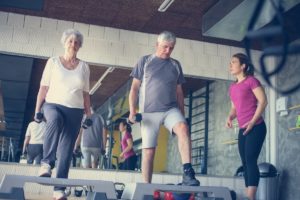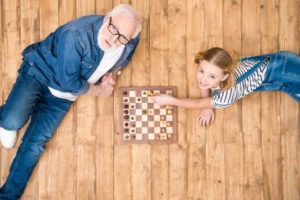Functional Aging/Older Adults
The Power of Simple Lifestyle Changes
Lifestyle choices have a significant impact on quality and length of life. With many Americans living longer than ever, fitness pros are on the front lines of a complex challenge: How will we help people remain active and engaged from their 60s into their 90s and beyond? How can we help them stay healthy to rein in healthcare costs?
The Link Between “Tip-of-the-Tongue State” and Cardio Training
It might be time to motivate your senior clients to do more cardio. Evidence suggests that aerobic exercise can improve language skills by positively affecting brain regions associated with language processing. A recent study found that fitness and language skills are related, with cardiovascular fitness levels in healthy older adults directly linked to the ability to retrieve words hovering on the “tip of the tongue.”
Integrating Cognitive Training Into Exercise Programs for Older Adults
How can you “cognify” exercises to give your clients a big kick in the hippocampus? The basic ideas here can help you integrate cognitive stimuli into most exercises.
Inspiring Functionality
CLIENT: Erika Miller
PERSONAL TRAINER: Michele DeJesus, MS (movement therapy), PhD (nutrition)
LOCATION: Lexington Athletic Club, Lexington, Kentucky
Older Adult Fitness & Your Business
The aging of the global population is single-handedly forcing and inspiring change in many ways—both obvious and subtle. The continued growth of the older population for the next 30+ years will influence the fitness industry in ways that we probably can’t even imagine yet. To help you prepare for this growth, here are some noteworthy aging trends (counting down from least to most important from a business standpoint) that could affect you over the next 5–10 years.
Trend #5: Brain Fitness Comes of Age
Pilates and Fall Prevention
As many as one-third of all adults over 65 years old fall each year, with consequences that include serious injury, limited activity and significant costs. Researchers at California State University, Northridge, conducted a study that shows that Pilates reformer training—as little as once per week—can effectively reduce these risks.
Hormone Health and Functional Aging
Functional fitness is of particular importance when working with older adults, since aging is accompanied by a progressive decline in multiple physiological functions, including the ability to perform daily activities. The topic of “functional aging” addresses this ability (or lack thereof) and is becoming more and more relevant, given the increase in people 65 and older and the disability rates in this population.
Learn the endocrine system’s pivotal role in aging and how exercise can impact it.
5 Top Trends in Older-Adult Fitness
The aging of the global population is single-handedly forcing and inspiring change in many ways—both obvious and subtle. The continued growth of the older population for the next 30+ years will influence the fitness industry in ways that we probably can’t even imagine yet. To help you prepare for this growth, here are some noteworthy aging trends (counting down from least to most important from a business standpoint) that could affect you over the next 5–10 years.
Trend #5: Brain Fitness Comes of Age
Stay Strong to Increase Longevity
Here’s more motivation to stay on top of your functional strength training program. Researchers from China and Indiana University analyzed data from 4,449 older adults in the National Health and Nutrition Examination Survey and found that older people with low muscle strength had more than twice the risk of dying during the study than those with normal muscle strength.
Functional Aging and Hormone Health
Understanding functional aging and the impact of activity on hormones can arm fitness trainers to help clients with their active aging goals.
Functional Training for Active, Independent Living
Healthy aging is more than the absence of disease, according to the World Health Organization: “For most older people, the maintenance of functional ability has the highest importance” (WHO 2015).
Colin Milner, founder and CEO of the International Council on Active Aging in Vancouver, British Columbia, echoes that statement: “When looking at the healthy aging market today, the focus is all about function. The World Report on Ageing and Health (WHO 2015) focuses on function as a key element, because loss of functional abilities significantly impacts life quality. Having a chronic health issue, like diabetes or high blood pressure, is manageable, but if I can’t stand up, everything changes.”
A Defense Against Age-Related Slowing
Age-related slowing of movement plays a critical role in the declining health of older adults. Slowing typically begins after age 62 with a marked decrease in gait velocity. It can lead to dysfunction, poor mental and physical health, a loss of independence and higher risk of mortality.
The Optimal Amount of Exercise for Heart Health
Arterial stiffness, which increases with sedentary living, is associated with higher risk of heart disease. It’s well known that exercise can help, but how much—or how little—is enough?
“While near-daily, vigorous lifelong (>25 years) endurance exercise training prevents arterial stiffening with ageing, this rigorous routine of exercise training over a lifetime is impractical for most individuals,” noted the authors of a new study, which aimed to determine the least amount of exercise necessary to reduce arterial stiffness.
Exercise Doesn’t Slow Dementia, Say Researchers
Research has supported exercise as having the potential to keep dementia at bay or at least to impede its progression. A recent study suggests that physical activity may not be as effective at warding off cognitive decline as previously thought.
In this study, published in BMJ (2018; 361, k1675), 329 individuals were assigned to an exercise intervention, while 165 subjects received “usual care.” Average age was 77, and each participant had a clinically confirmed dementia diagnosis.
How Fast You Walk May Affect How Long You Live
Want to outwalk the grim reaper? Pick up the pace, say researchers. A new study from the United Kingdom suggests that quicker walking may add years to your life.
The study’s primary aim was to examine the impact of walking pace and volume on all-cause mortality. To determine this, researchers looked at mortality records for 50,225 individuals from Scotland and England who had self-reported their walking data via interview.
Exergaming May Improve Independence Among Older Adults
Maybe you’ve thought about integrating exergaming—exercise combined with video games and other elements of technology—into some of your classes or sessions. Don’t forget to include older adults. A recent study found that seniors with mild cognitive impairment (MCI), a precursor to Alzheimer’s, showed significant improvement in certain complex thinking and memory skills after exergaming.
Stand Up to Aging
Getting up off the ground grows more difficult as we age. Muscles and bones weaken, coordination becomes less fluid, and simply doing chores around the house gets more challenging. Ground-to-standing (G2S) exercises address these changes. hile even performance athletes can benefit from G2S drills (see the sidebar “G2S Exercises Also Help Performance Athletes”), they’re supremely helpful for older exercisers who are at risk for broken hips and other threats to their mobility.
Bone Loss: A Primer
Bone loss is a normal part of aging, and understanding it can help fitness professionals to develop preventive strategies for their clients.
A New Way to Combat High Blood Pressure During Menopause
Researchers have linked menopause with arterial stiffness and high blood pressure. A recent study of Korean women, led by The North American Menopause Society, suggests that taking the stairs is a good way to manage those conditions.
The Best Exercise for Alzheimer’s Disease
If you were asked to choose among cardiovascular exercise, resistance training and a combination of both to help people with Alzheimer’s disease, what choice would you make?
Researchers from the University of Connecticut wanted to understand the effects of exercise—if any—on cognitive decline in those at risk of or diagnosed with Alzheimer’s. The scientists performed a meta-analysis of 19 studies (23 exercise interventions) featuring 1,145 adults aged 77 ± 7.5 years.


